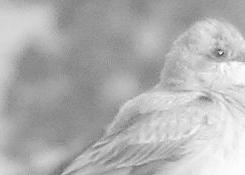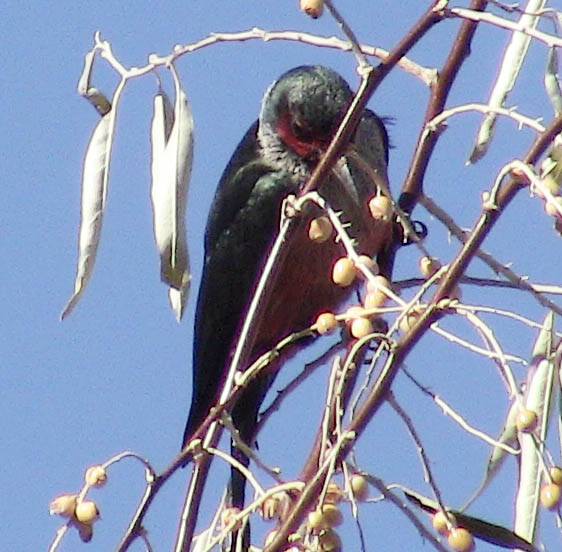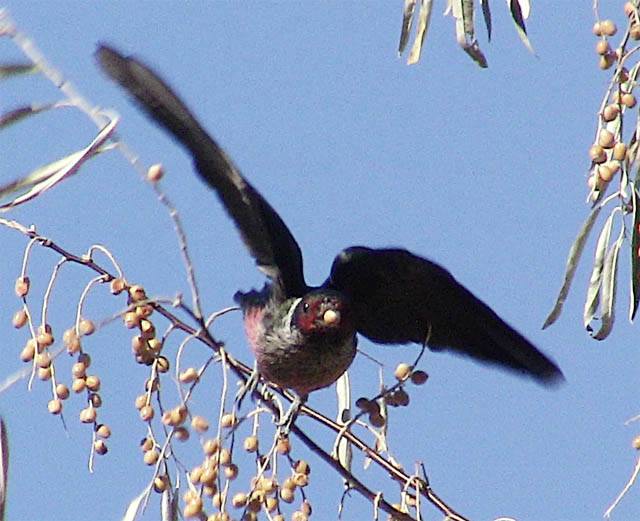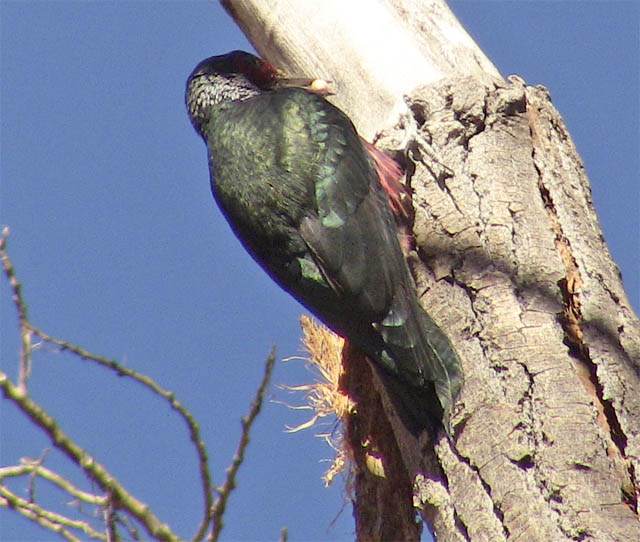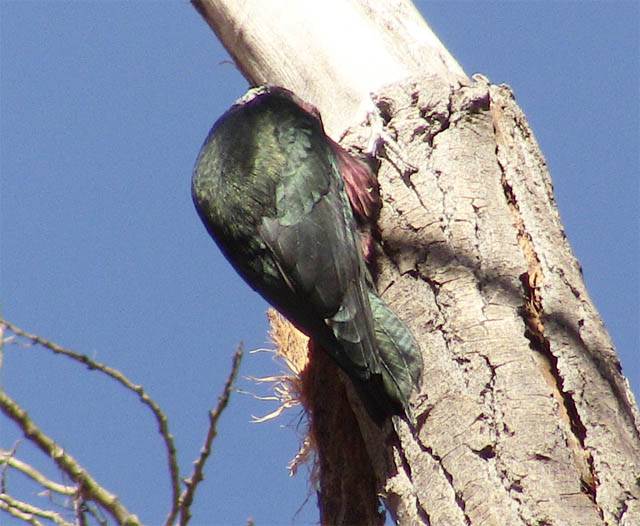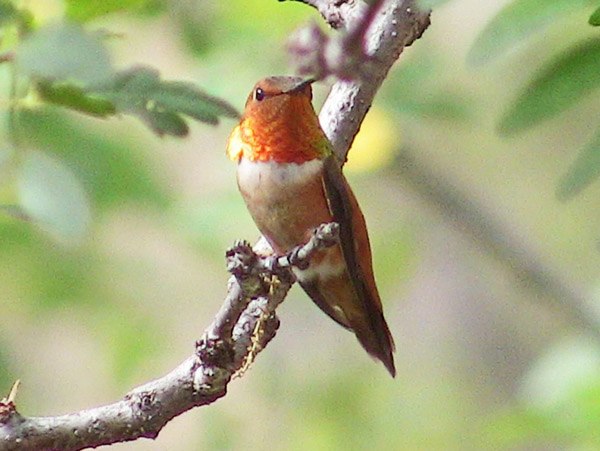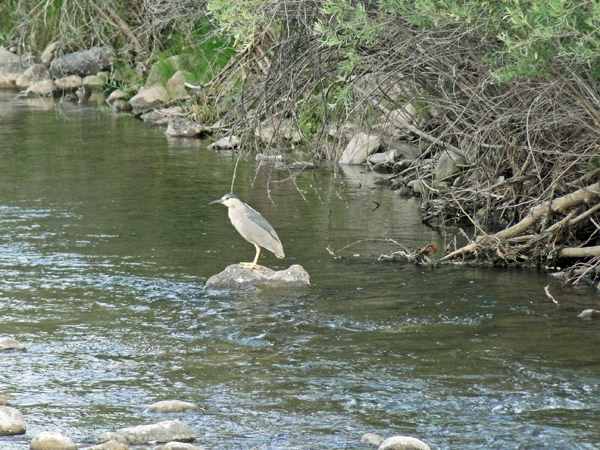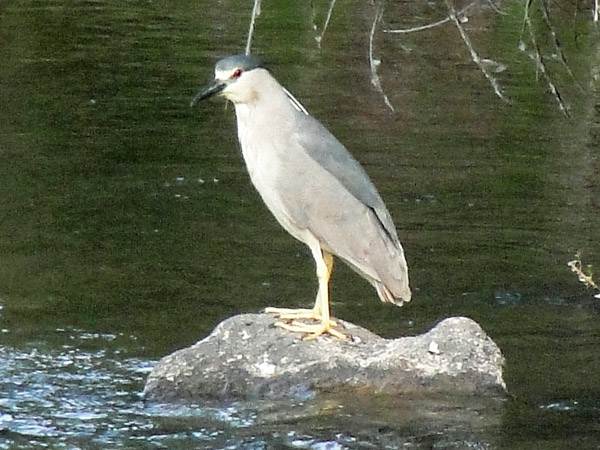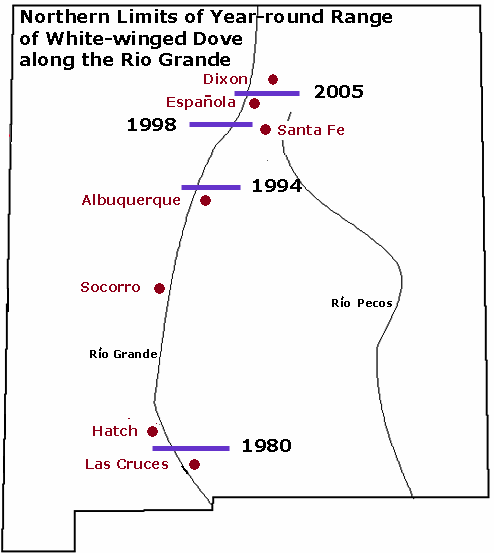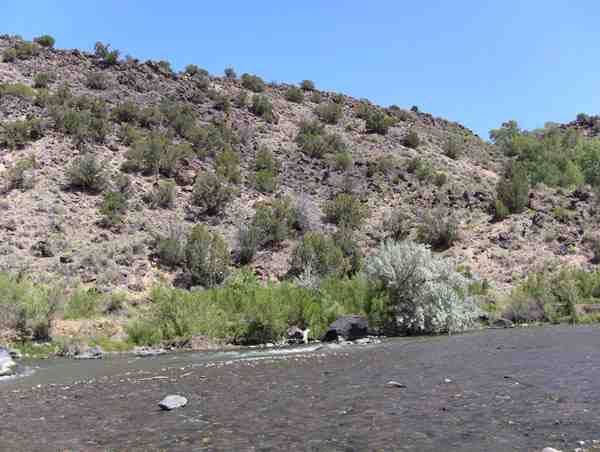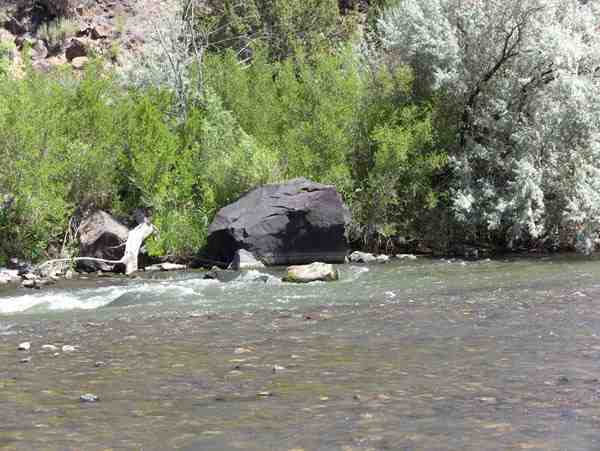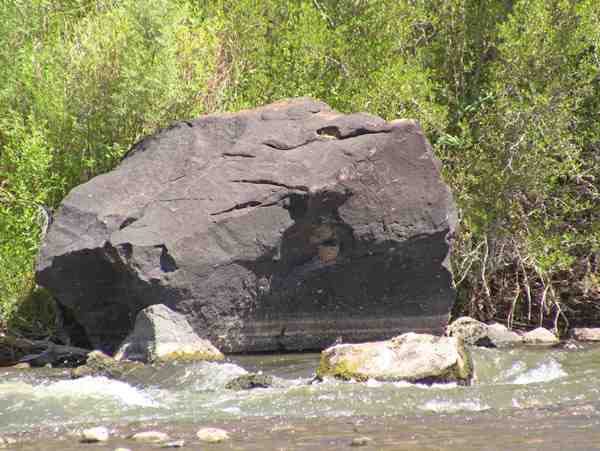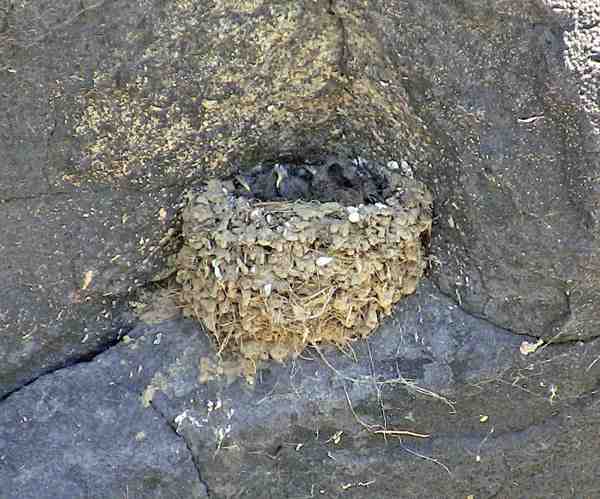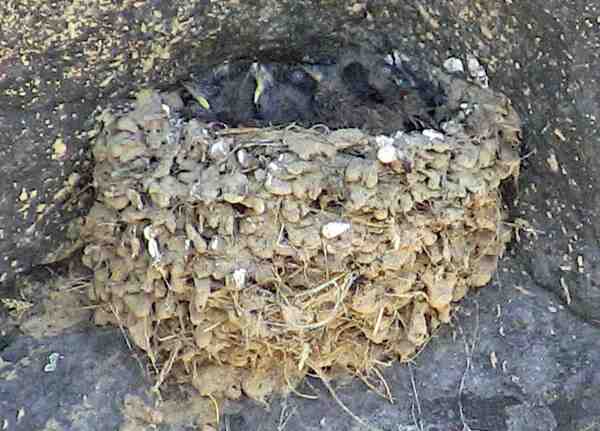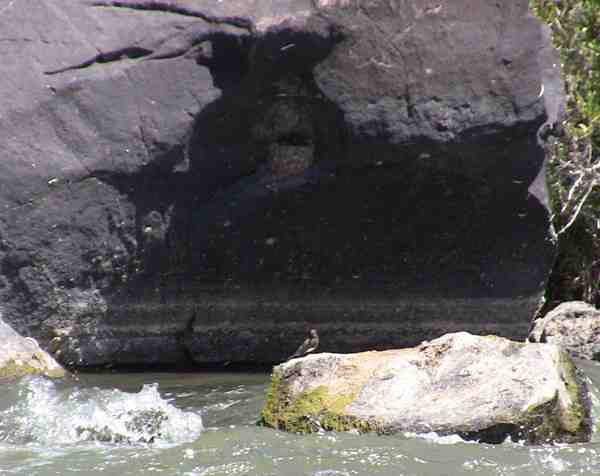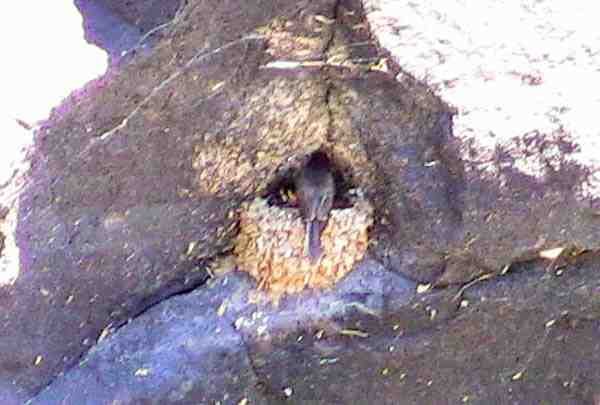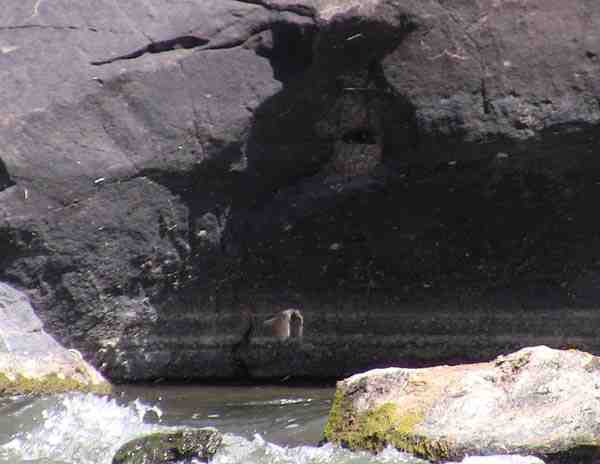- List of Species Observed in RioEmbudoBirds.org area (Updated 2023):
- All Seasons, All Species
- Species Present All Year
- Winter Visitors
- Spring-Fall Transients
- Migrant Summer Breeders
- Non-breeding Vagrants
- Observing Birds
- Local Bird Counts
- Bird Migration
- Bird Song and Sound
November 14, 2012:This Lewis's Woodpecker (Melanerpes lewis) was photographed on the Río Grande in Rinconada. It was gathering Russian Olive fruit in a tree right on the bank of the river. It would then fly to a nearby Cottonwood tree where it appeared to be storing the fruit in crevices in the bark. It repeated this process over and over for at least half an hour.
In the Russian Olive:
|
July 26, 2012:Most of the hummingbirds seen in the Embudo Valley during the spring migration and the summer breeding season are either the Broad-tailed Hummingbird (Selasphorus platycercus) or the Black-chinned Hummingbird (Archilochus alexandri). The hummingbird species pictured below is only rarely seen in the area during the spring migration as it makes its way from its wintering grounds in central Mexico to its breeding grounds along the Pacific coast from Oregon to southern Alaska. However, after its breeding season up north is over, it begins its Fall migration back to Mexico. In the Embudo Valley, they begin appearing by July 1st and within a week, large numbers are present. This species is well known to anyone in the valley with a hummingbird feeder, because the males very aggressively guard the feeders, excluding most Black-chinned and Broad-tailed Hummingbirds from accessing the feeder. Fortunately, feeders represent only a small portion of a hummingbirds food supply. The majority of their food comes from drinking nectar from the many flowers that bloom in the valley. This
Rufous Hummingbird (Selasphorus rufus)
was guarding a feeder in El Bosque on Thursday, July 27 in the late afternoon:
The Rufous Hummingbirds will continue to be present until about the 3rd week of September. After that, they, along with the Black-chinned and Broad-tailed Hummingbirds will all be making their long journey to Mexico, fueled by sipping nectar from wild and garden flowers along the way. An amazing journey for a bird that weighs less than two-tenths of an ounce. |
July 9, 2012:One of the most common sounds in the Embudo Valley, in fact, in all of Northern New Mexico is the song of the Spotted Towhee (Pipilo maculatus). It is not uncommon to see one singing its song from the top of a small tree in the spring or summer. (See March 3, 2011 entry below to hear the song.) But the Spotted Towhee also makes a more subtle "catlike" growl. One is very likely to hear it if you go for a walk anywhere in irrigated land or riparian areas. The Towhee uses it as a contact call, letting another family member know where it is. Since Towhees spend a lot of time at the base of shrubs scratching for insects in the dead leaves, one rarely sees one make the contact call. The Towhee in the video was repeatedly making the contact call in the open. The light was not good for photography, but I couldn't pass-up the opportunity. This bird seems a little upset. Possibly is has lost track of a mate or an offspring. Or maybe I am near its nest and it is trying to distract me. |
July 1, 2012:Everyone is used the seeing the Great Blue Heron along the Río Grande. Occasionally one even makes its way up the Río Embudo. I have seen them from the El Bosque Bridge on numerous occasions. But during the summer, another Heron is in the area, the Black-crowned Night-Heron Nycticorax nycticorax. Measuring about 2 feet in length, the Night-Heron is about half the height of the Great Blue. But when the Great Blue pulls its neck down against its breast, the birds can appear about the same size. A closer look reveals numerous distinctions: Bill color; Leg color; Eye color; the dark crown of the Night-Heron which extends down the back of the bird. Here are two views of the Night-Heron looking north from El Bosque bridge on July 1st:
After a minute or so, the bird flew and as we turned around to continue walking, two more Night-Herons took flight from the riparian area south of the bridge. So we were probably seeing a family group following a successful breeding season. |
June 30, 2012:The Northward Expansion of the White-winged Dove in New Mexico along the Río Grande.The White-winged Dove (Zenaida asiatica) was observed on the Dixon CBC for the first time in 2010. It appeared again in the 2011 count. The table below shows historical data from New Mexico Christmas Bird Counts along the Río Grande Valley. These changing northern limits of the year-round range are shown on the map at the right. If you consult range maps in various field guides, you will find a great variation in the described breeding and wintering ranges. This is clearly a result of the rapidly changing distribution of the species. Range maps created before 1980 will show the year-round range reaching only about 50 miles into southern New Mexico (Just north of Las Cruces), with the breeding range extending another 10-20 miles north. Most maps produced closer to the turn of the century still show the year-round range barely reaching into New Mexico, but show the breeding range reaching as far north as Albuquerque. This is the case for the original Sibley's published in 2000. However, when Sibley published his guide to the western birds in 2003, the range map had been updated to show the year-round and breeding ranges in Río Grande Valley to be identical. When the Las Cruces CBC was begun in 1975, small numbers of wintering White-winged Doves were observed. As you can see in the data, by the 1990s many birds were over-wintering and by 2000 the year-round population had exploded into the tens of thousands. 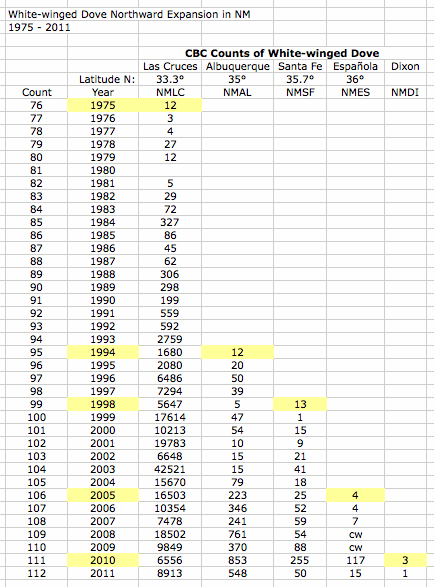
The further expansion north is clearly shown in the data. Though the Albuquerque and Santa Fe counts have been active since the early 1960s, the first wintering White-wingeds were not recorded in Albuquerque until 1994 and in Santa Fe until 1998. As you can see, the first records in the Española CBC were in 2005. The Espanola count has been active since the 1950s. There is a new Peterson's guide out now with recently updated range maps. The new map shows the Rio Grande valley year-round and breeding ranges as being the same and reaching as far north as Santa Fe. Additionally it shows a major northward expansion of the breeding range on the east side of the Rocky Mountains into southern Colorado with the year-round range on the plains reaching as far north as Clovis, NM. What we appear to be witnessing is a range expansion being led first by migrants into new territory, followed by some over-wintering groups forming year-round breeding populations. In general, we know that the migration of birds is driven primarily by food. If there are changes in the distribution and/or migratory patterns of a species, it is likely that there are changes in food availability in the areas involved. If this is the case here, might it be related to changes in agricultural activity? Might climatic changes be involved as well? Click here for more info about the White-winged Dove from Cornell's All About Birds.Source of data: National Audubon Society (2010). The Christmas Bird Count Historical Results [Online]. Available http://www.christmasbirdcount.org [January 2011] |
An Interesting Nest (June 29, 2012)Photos taken on June 29, 2012 North side Río Grande near Taos County line.
Note the dark rock west of the Russian Olive.
A closer view reveals a mud nest in the depression of the rock.
The Black Phoebe, a flycatcher, makes a mud nest like this.
A closer view showing at least three young.
Black Phoebe adult on rock near the nest.
Adult Black Phoebe feeding the young.
Adult returning to rock in the river.
|
|

|
Copyright 2006-2021 by Rio Embudo Birds.org --- All rights reserved.
